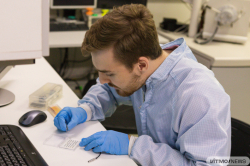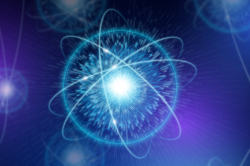Electrons can behave as both particles and waves – meaning that they can assume different forms, thus changing their properties. One of the possible electron “shapes” is a screw: the particle twists in a spiral around itself – that’s why such particles are known as twisted. Such particles have already been used in experiments with electron microscopes. Now, the researchers are hoping to study their properties in particle accelerators, where electrons are accelerated by electric and magnetic fields to significantly higher energies: they move faster and have a stronger impact on the surrounding particles. Such experiments will help uncover more about matter.
Conventionally, electrons are twisted using a special lattice: as they pass through it, the particles acquire a screw shape. However, this method is only viable with slower electrons. In accelerators, electrons move significantly faster than in regular conditions, which makes it impossible to “twist” them via conventional methods. To do this, the lattice’s grating period would have to be smaller than an atom – and this can’t be achieved due to fundamental physical and technological limitations.
Physicists at ITMO have suggested a method of twisting electrons that would simultaneously “herd” them into a collider. First, a laser beam passes the photon-twisting lattice; next, the twisted photons pass through crystals and turn infrared. Then, the photons “hit” a metal plate, “hammering” the electrons – which have now acquired their twists – into a collider. According to the team’s calculations, the method will be functional in any conditions: in the ideal scenario, when atoms are situated on the laser beam’s axis and the twist is “passed directly” with the same value; and in real conditions, when the twist is passed “with a margin of error” to several atoms scattered in an area.
“When we talk about a twisted electron, we imply a single particle. However, that’s only in theory – in reality, we observe a beam of such particles. And in order to track the properties of each of them with high precision, we have to “launch” the smallest possible number of electrons into the collider. Otherwise, they will interact with each other and lose their “individual” properties – and as a result, we’ll get the same classic system. However, the size of beams – the number of electrons in them – can be regulated by increasing or decreasing the laser beam’s intensity. The size of individual atoms can be regulated via the wavelength. That’s why such experiments have to be conducted with small currents, so that electrons enter the collider one by one and maintain extra weak interaction,” explains Master’s student Ilya Pavlov, one of the paper’s authors.

Ilya Pavlov. Photo courtesy of the subject
Experiments with twisted electrons will provide more insight into how protons and neutrons are “assembled” within the nucleus of an atom and how they interact with other particles. Additionally, the researchers believe that the new data obtained during the experiments will bring them closer to understanding the nature of quarks.
Right now, the scientists’ main goal is to test the new method in practice. Their colleagues from the Joint Institute for Nuclear Research in Dubna are working on an installation for the experiment: they are installing a lattice on a laser, connecting it to a collider, and establishing a system of “connections” between them. The twisted electrons are slated to be “launched” into the collider by the beginning of 2025. Moreover, the researchers are planning to continue their theoretical work: the advanced model will take into account the effect of the lattice on photons and the energy transfer that occurs not only from light to electrons, but from light to atom nuclei. This way, the model will become more precise and closer to real-world conditions.
This Russian Science Foundation-supported project is conducted by a team of scientists headed by Dmitry Karlovets, DSc, leading researcher at ITMO’s Faculty of Physics, comprising Alisa Chaikovskaya, DSc, and Ilya Pavlov, a Master’s student at ITMO.





